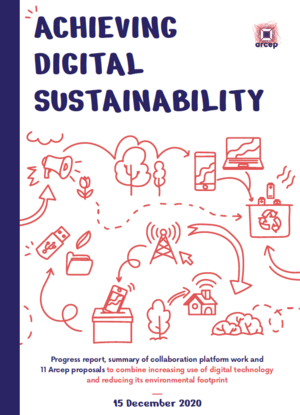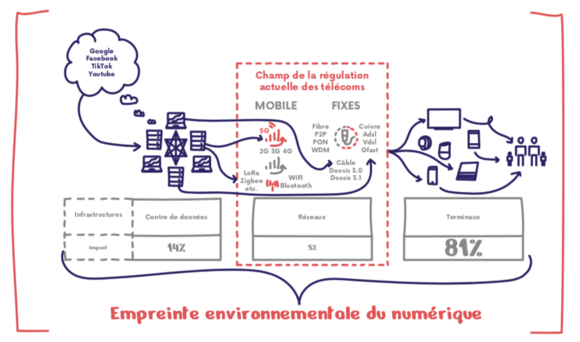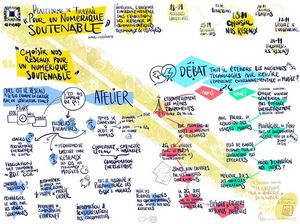On 11 June of this year, Arcep launched a collaboration platform devoted to “Achieving digital sustainability” – calling on all interested associations, institutions, operators, digital industry businesses and experts to contribute. After six months punctuated by five thematic workshops and two “big discussions,” today Arcep is publishing a progress report on the work done thus far, which includes 42 contributions authored by the participating players. In this report, the regulator sets forth 11 proposals for successfully combining the ongoing increase in the use of digital tech and reducing its environmental footprint.
Digital can and must join the low-carbon strategy, without having to give up business and innovation opportunities
To ensure that communication networks can continue to develop as a “common good,” today Arcep wants to incorporate environmental issues more thoroughly into its day-to-day actions, and in the proposals it is brought to formulate.
With this progress report, Arcep acknowledges that digital technology can and must be part of the low-carbon strategy, without having to forego any technology-driven business or innovation opportunities. The purpose is not to deliver a blanket condemnation of technology, nor to rein in or restrict its use out of hand: certain applications in fact contribute directly to reducing greenhouse gas emissions. But nor should digital technology be seen as a sector exempt from doing its part to comply with the Paris Climate Agreement and its new targets. The Citizens’ Convention on Climate notes that although digital tech is a vital enabler of the green transition and the battle against global warming, it must not itself be a source of increased emissions.
Arcep is therefore proposing to take a middle path between the two pitfalls of laissez-faire and administered economy. Galvanising the instrument of regulation to act as the bridge between market initiative and imperative for the greater good.
Everyone must be responsible for achieving low-carbon technologies: public policymakers, the regulator, economic stakeholders and consumers
In these times of growing awareness, Arcep’s proposals seek to propel this mobilisation, creating a momentum to drive it past the stage of good intentions and onto a concrete, ambitious path for reducing the environmental footprint. This means drafting environmentally-aware digital regulation, which covers not only telecoms operators but also device manufacturers, online content and application providers, datacentre operators… Consumers too can play an active role, provided useful information is made available to them, through a data-driven approach to regulation.
In terms of concrete action, this approach and the 11 proposals formulated by Arcep can be broken down into three strands:
- Strengthen public policymakers’ capacity to steer digital tech’s environmental footprint;
- Incorporate environmental issues into Arcep’s regulatory actions;
- Increase incentives for economic stakeholders, private and public sector players and consumers.
The 11 proposals are set forth in detail in Annex 1.
Arcep wants its actions to be consistent with those carried out by public authorities, notably ADEME
An integral part of Arcep’s process is an ongoing dialogue with public authorities. The High Council on Climate, as well as the Senate task force on digital technology’s environmental footprint both solicited Arcep’s input. The quantified data and the avenues proposed in a report published by the Senate helped further the regulator’s investigative process. The French government’s roadmap to reduce digital tech’s environmental impact also created an opportunity for in-depth discussions with Barbara Pompili, Minister for the Ecological Transition, and Cédric O, Secretary of State in charge of the digital transition and electronic communications. Arcep also deepened its collaboration with ADEME, France’s Environment and Energy Management Agency (ADEME) in charge of the green transition, with which it shares a joint mission, entrusted by the Ministry for the Ecological Transition, and the Ministry for Economy and Finance. A dedicated joint report on the resulting work will be published in late 2021.

Arcep extends its thanks to the “Achieving digital sustainability”collaboration platform’s 127 participants and the 42 stakeholders who freely offered to contribute to the report
To better understand and tackle the issues surrounding digital technology’s environmental footprint, Arcep wanted to listen to the many voices of digital and environmental stakeholders – through meetings with experts centred around a particular theme, but especially as a way to decompartmentalise debates and gather input from as broad a spectrum of players as possible, by developing a space for dialogue, within the “Achieving digital sustainability” collaborative platform. Co-hosted with the Ouishare collective, to think together about digital sustainability in tomorrow’s society, these moments of meeting and talking created opportunities for everyone to share their visions, practices, tools and skills. And to better showcase the positions and proposals, all of the participants were invited to make a written contribution.
In keeping with this approach, Arcep’s report is composed of three strands:
- THINK, to take stock of digital sustainability issues and challenges;
- LISTEN, to enrich the dialogue with collaboration platform participants, and share their written contributions
- ACT, to turn talk into concrete actions and champion the proposals
Arcep extends its sincere thanks to the authors of the 42 contributions, that are the heart of this report: associations, think tanks, tech companies, institutions, local authorities, researchers… each one delivers singular insight into how we can tackle this issue together.
The 42 contributions to Arcep’s “Achieving digital sustainability” report were authored by:
Ademe, Afnum, Aktio, Altitude, Avicca, Béatrice Bellini, chercheur, Bouygues Télécom, Commissariat général au développement durable (CGDD), CLCV Ile de France, Conseil national du Numérique, Commown, Vincent Courboulay, chercheur, COVAGE, Criteo, CSA, Digital Green, Ericsson, Facebook, Familles Rurales, FFTélécoms, Flipo Fabrice, chercheur, France urbaine, France Ville Durable, GIMELEC, Google, Green IT, HADOPI, Halte à l’Obsolescence Programmée, Les Augures, Métropole Européenne de Lille, Negaoctet, Numerisat, OVH Cloud, Qarnot, Roussilhe Gauthier, chercheur, SNCF, TeleCoop, The Shift Project, Tibco, UFC Que Choisir, Vodafone, Wifirst.
Path to be defined by public policymakers
Adopting green tech regulation is a decision that falls to government authorities, and Arcep’s role here is to be a source of proposals. It is up to the government to define the scale of ambition, and especially how to set the digital tech sector on the path to committing fully to the low-carbon strategy. It is also up to public policymakers to enshrine in law the tools of transparency, incentive and, if necessary, requirements that will lend substance to this regulation, and undergird the institutions tasked with using them.
Implementing proposals and keeping the dialogue going
In 2021, as part of its duties, Arcep will promote the proposals formulated in the report, and will continue to work with stakeholders to deepen everyone’s expertise, public authorities’ knowledge and develop solutions. As it has done with consumer associations and the internet community, Arcep also wants to keep the dialogue going, to continue to expand the process of listening and mutual enrichment that has been so vital from the start. To this end, it will propose to the platform’s participants, and any other players wanting to join the process, to meet again in mid-2021 to take stock of how the proposals and, more generally, digital tech’s environmental footprint have evolved.
Associated Documents:
• Achieving Digital Sustainability - Progress report (english version)
• Press release of 11 June 2020 announcing the launch of the platform
• Collaboration platform: Achieving digital sustainability
Annex 1:
Arcep’s 11 proposals to combine increasing use of digital tech and decreasing its environmental footprint
STRAND 1: STRENGTHEN PUBLIC POLICYMAKERS’ CAPACITY TO STEER DIGITAL TECHN’S ENVIRONMENTAL FOOTPRINT
- Entrust a public entity with the power to collect useful information from the entire digital ecosystem (content and application providers, operating system developers, device manufacturers and datacentre operators, in addition to electronic communications operators for which this type of mechanism already exists) to be able to obtain granular and reliable data that is crucial to assessing and monitoring the sector’s environmental footprint, and the measures that have been implemented.
- As part of its initiatives with ADEME, participate in the creation of a common frame of reference for measurement: Improve measurement to better identify the issues, compile data to keep users informed and foster a virtuous dynamic in the sector.
STRAND 2: INCORPORATE ENVIRONMENTAL ISSUES INTO ARCEP’S REGULATORY ACTIONS
For fixed access
3. Facilitate the transition from copper to fibre.
4. Encourage network optimisation by promoting civil engineering infrastructure and fibre infrastructure last drop (access network) sharing schemes.
5. Encourage initiatives designed to implement automatic sleep mechanisms in operators’ boxes, at certain times of the day or when not being used for long stretches of time.
For mobile access
6. Achieve more detailed analysis of the positive and negative impact of switching off 2G and 3G networks, to lift potential barriers and ensure that the right incentives are put into place. European regulation on in-vehicle emergency calls (e-call) in particular warrants in-depth examination, working in tandem with the Government.
7. Examine network performance indicators in 2021, to incorporate environmental issues in consumer choice parameters.
8. Work with interested stakeholders to explore solutions for optimising mobile networks’ medium and long-term environmental impact, focusing in priority on sharing issues and making the best possible use of frequencies.
9. Develop, if appropriate, more detailed monitoring of operators’ handset subsidy practices and their effects.
STRAND 3: INCREASE INCENTIVES FOR ECONOMIC STAKEHOLDERS, PRIVATE AND PUBLIC SECTOR STAKEHOLDERS AND CONSUMERS
10. Work with interested stakeholders to draft Codes of conduct/charters to buttress green design, and which are capable of leading to the adoption of legally-binding commitments, akin to electronic communications operators’ regional digital development commitments, and commitments to cover the country’s sparsely populated areas with electronic communications’ networks (Art. L.33_13 of the French Postal and Electronic Communications Code (CPCE)). Notably:
• content and application providers, particularly the largest, most influential ones (e.g. over best practices such as adapting content resolution to the device’s screen, or limiting autoplay);
• operating system developers, particularly the largest, most influential ones (e.g. over best practices such as maintaining older versions of their OS, or taking better account of obsolescence issues in updates);
• datacentre operators (e.g. over best practices such as data centres’ architecture, optimising cooling systems, or managing storage equipment…).
Other proposals in line with this incentive-based approach are regularly put forth, such as introducing mechanisms designed to convey price signals that heavily affect content and application providers, e.g. regarding bandwidth use. This type of solution could be useful if codes of conduct fail and, in any event, warrant closer analysis.
Compliance with codes of conduct must be monitored by a public entity with supervisory and, if applicable, sanctioning powers.
11. Increase users’ accountability and their ability to take action through a data-driven approach to regulation, fostering the emergence of tools for aiding consumers in making choices, and understanding their impact on the environment.Publish a “Green Barometer” to help showcase best practices from across the digital ecosystem.
Annex 2:
Achieving digital sustainability: Key figures and data
Annex 3:
The “Achieving digital sustainability” collaboration platform: five workshops and two big discussions, conducted with the Ouishare collective
On 11 June, Arcep launched a collaboration platform devoted to “Achieving digital sustainability”. The inaugural meeting held online on 9 July with associations, institutions, operators and digital industry companies who answered the call provided an opportunity to establish the main issues, and to work on publishing a detailed work programme (pdf - 269 Ko) for the workshops and discussions. Helping Arcep to design and host these workshops and discussions is Ouishare – a collective that explores and challenges societal transformations through live encounters, studies and concrete experiments.
Five thematic workshops to identify potential courses of action on each link of the user experience chain
From buying a smartphone to the networks’ architecture, the aim of the five themes chosen for the workshops is to explore each of the links in the user experience chain, to identify best practices and potential courses of action, be it educating consumers or rethinking how the sector’s players do business. These workshops will provide an opportunity for everyone to share their views, practices, tools and skills, and so fuel this collective brainstorming
- Adapting business practices to achieve digital sustainability
- Combating obsolescence to achieve digital sustainability
- Choosing our networks to achieve digital sustainability
- Rethinking digital content and services to achieve digital sustainability
- Designing networks (architecture, sharing) to achieve digital sustainability



